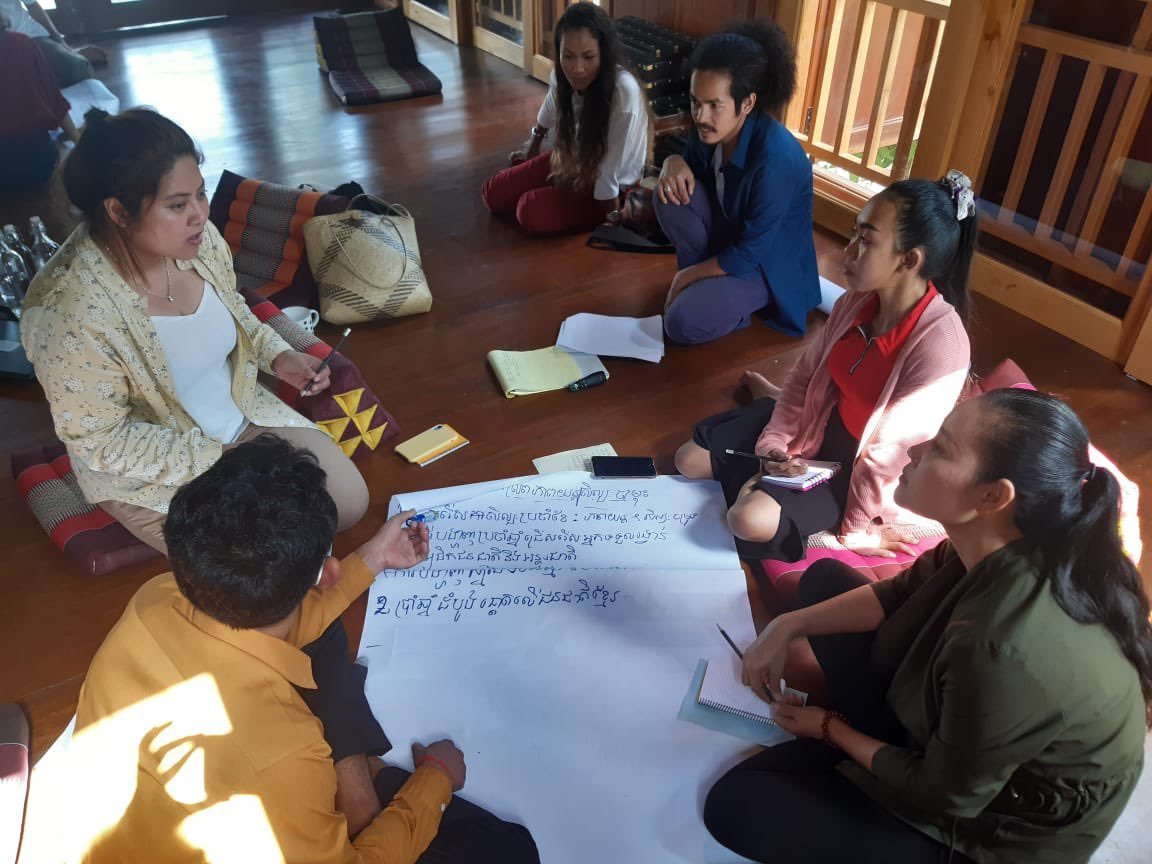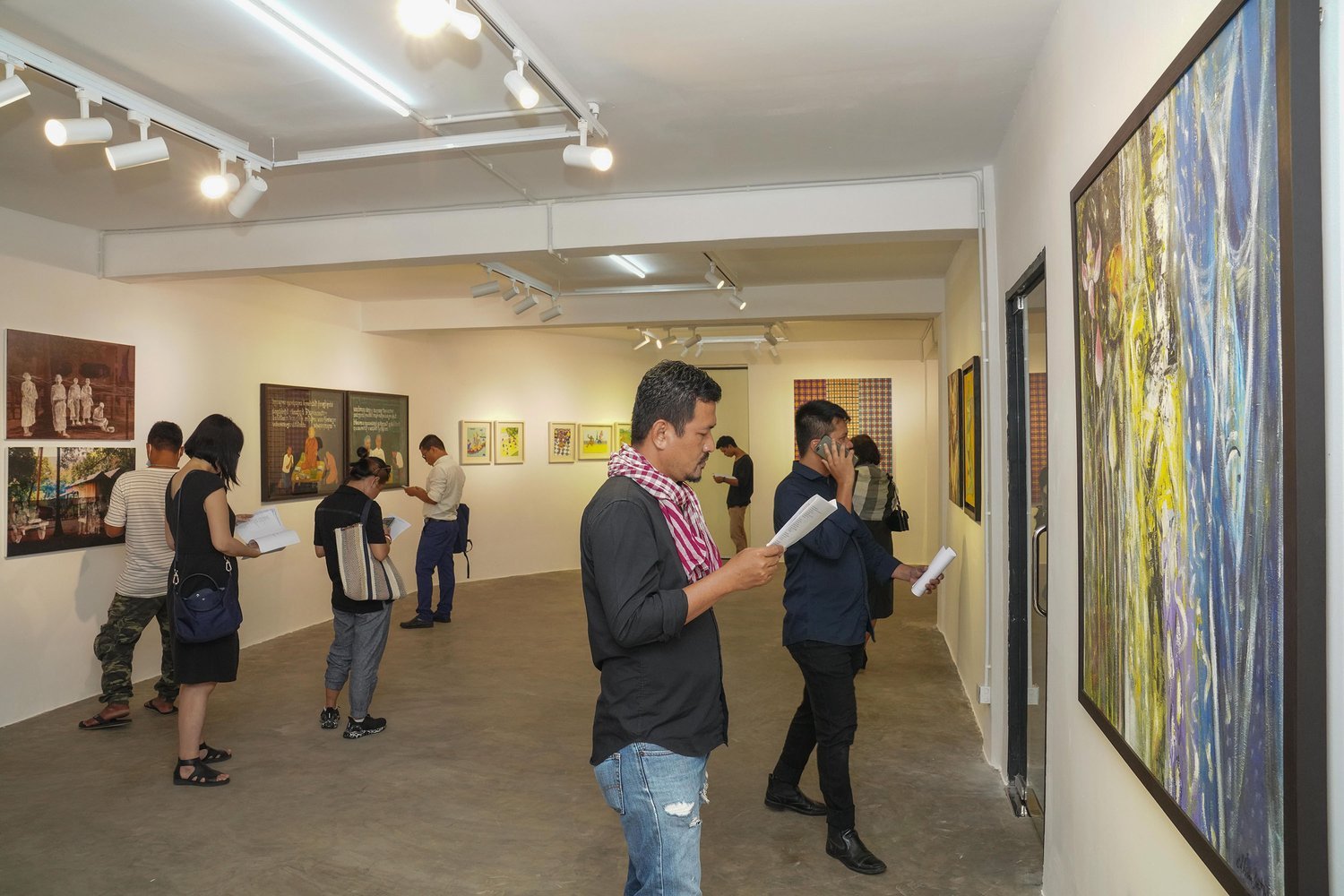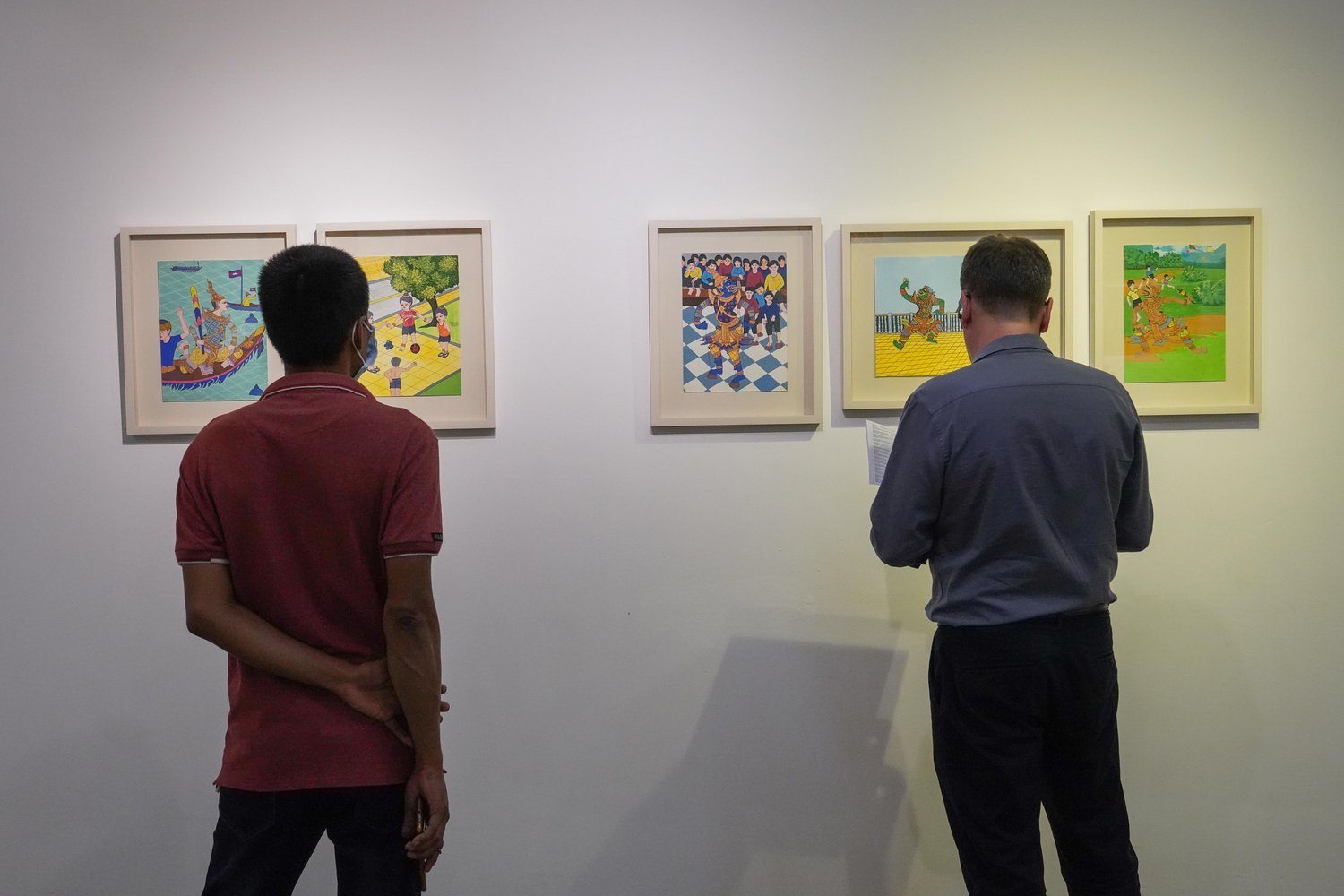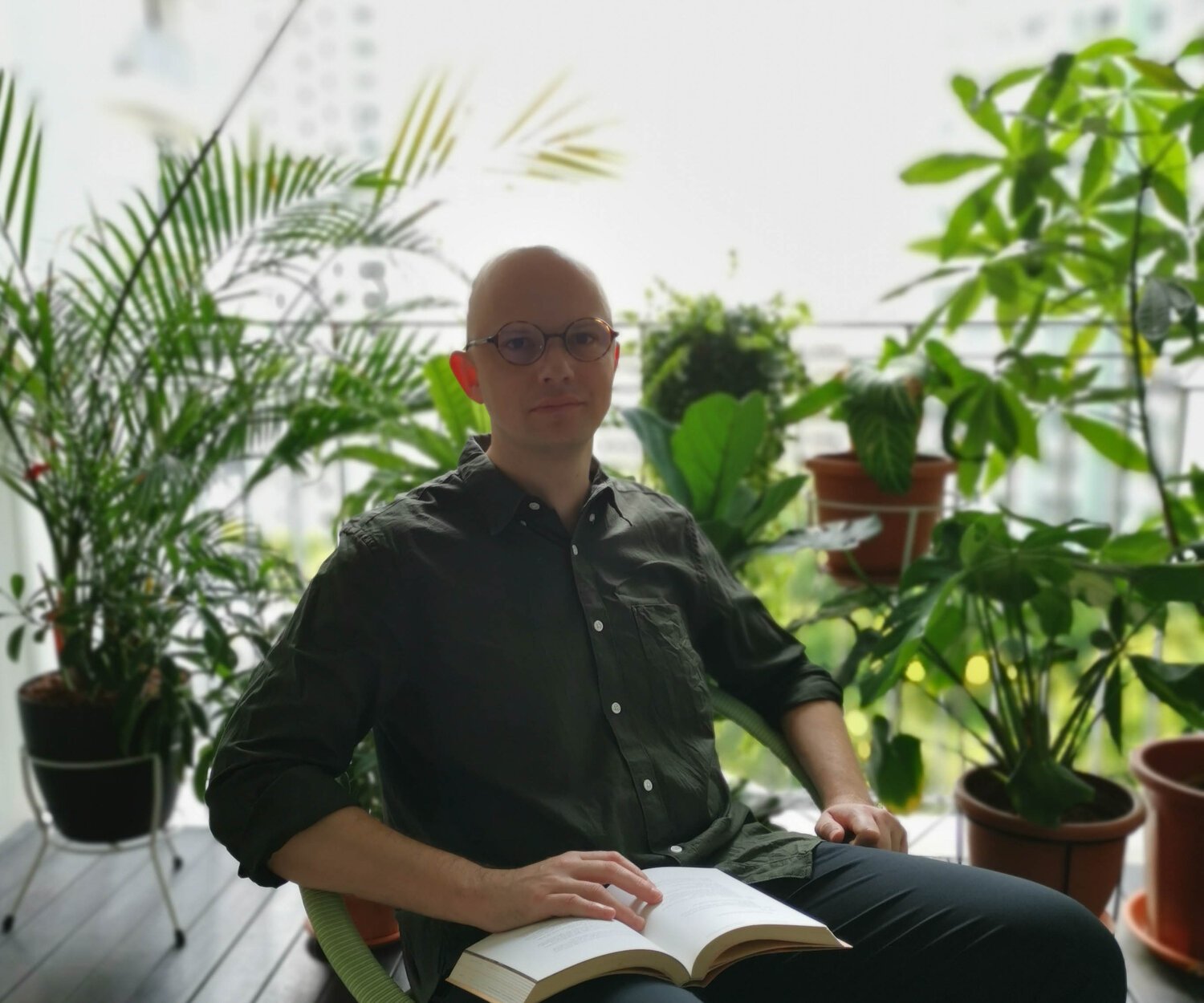Silapak Trotchaek Pneik
Reaksmey Yean on Cambodian visual arts
By Amanda Rogers
A native of Battambang, Reaksmey Yean is an art advocate, art curator, writer and researcher. He has been an Alphawood Scholar at the School of Oriental and African Studies, University of London, an exchange scholar at the Institute of Southeast Asian Affairs, Chiang Mai University, and in 2017 he became the first recipient of the SEAsia Scholars Award at LASALLE College of the Arts, Singapore, where he was also funded by an Asian Cultural Council fellowship. Reaksmey has been a curator for creative programmes at Java Creative Café, Phnom Penh, and has served in several senior posts, including an Assistant to the School of Performing Arts at Phare Ponleu Selpak, a multi-disciplinary arts centre in Battambang where he received his early education. Reaksmey is interested in multi-disciplinary contemporary art practice and recently opened the Silapak Trotchaek Pneik art gallery in Phnom Penh. As an art advocate, Reaksmey promotes art and culture in contemporary Cambodia via curatorial practices and art criticism. As a scholar, he is concerned with Buddhist art, contemporary and modern arts, Southeast Asia, and decolonial theory.
Reaskmey is currently finishing a position at the Centre for Khmer Studies as a co-investigator on the project ‘Contemporary Arts Making and Creative Expression among Young Cambodians.’ I am leading this project in collaboration with Cambodian Living Arts. It is funded by the UK’s Arts and Humanities Research Council and the Global Challenges Research Fund via the post-conflict research programme ‘Changing the Story’. Reaksmey and I first met when we were both invited to speak as part of a panel on ‘Heritage Arts and the Contemporary’ at the South East Asian Arts Festival in London in 2014. This was to open the exhibition of ‘Fractured/Khmer Passages’ by Thomas Buttery and Jai Rafferty, produced by Annie Jael Kwan. Reaksmey’s interests lie predominantly in the visual arts, whereas mine lie in contemporary Cambodian dance. Yet from this first encounter, it was clear that we both felt that a new direction was being forged by Cambodian artists across all spheres. The research project has been an opportunity for us to further explore these ideas, particularly regarding the extent to which the contemporary arts scene is influenced by the legacies of the Khmer Rouge. We have also been considering the prospects for the arts in a country where two-thirds of the population is under the age of 30. In this interview with Reaksmey I ask him to reflect on the current state of the visual arts scene in Cambodia, updating the record from seven years ago.
Reaksmey Yean in front of Chea Sereyroth's 'Children in Dumpsite' (2013). Photo by Bun Chan. Image courtesy of Silapak Trotchaek Pneik.
I want to start with what you call yourself, because I have heard you use many terms: articurize, critic, art advocate, writer, scholar, but you also trained in music and singing. It feels like you are experimenting with the terminology!
Yes, exactly! You know full well that I am one of those people who… not like to tag themselves into a particular model. That is why when people ask me what I would consider myself to be, the answer will vary. Before calling myself an art writer and curator, I called myself an art advocate. But then people who know me in the visual arts say, “Why don’t you just say that you are an art curator?” Well, yes, I am that too! However, I want to be free from the constraints of undertaking a particular career. I want to have a different path in the arts, and that also means being involved in cultural policy. I want to keep things more open because I want to effect change. I have a vision for the Cambodian arts scene and in order for me to realise that vision, I have to be part of the decision-making process.
Before we discuss what that vision is, can you tell me about the visual arts scene in Cambodia right now?
The visual art scene is suffering from the pandemic, but generally speaking, we are at an exciting moment. It is like a spring. We have many people who are practising art, so there are more artists. We have local players who support the visual art scene. There has also been the opening of art galleries that are run by either diasporic Cambodians or local Cambodians, myself included! This increase of human resources and curatorial expertise is crucial in the visual arts. I have fellows to discuss things with, to share ideas with, and that is exciting.
Reaksmey leading a session in an 'Arts for the Future' workshop in Phnom Penh, February 2021. Photo by Hem Vanareth. Image courtesy of Silapak Trotchaek Pneik.
To what extent is that centred on Phnom Penh?
Historically, Battambang was branded ‘The Art Centre of Cambodia’, and, of course, Phare Ponleu Selpak had a big part in fostering that. However, I am not sure whether it still enjoys that status. The creative scene in Battambang is quite slow and it is perhaps derivative as well. Battambang is also quite isolated because the infrastructure is always under construction. This means it gets cut out from resources, both financial and educational. Siem Reap is a different story because of tourism, and so artistic production up until the last two years has served the tourist market. Only two galleries – Batia Sarem and Mirage Gallery – defy the scene in that sense.
Phnom Penh is interesting because, of course, it is right in the middle of everything! We have international agencies such as the Institut Français and Meta House, but also other organisations like Asia Foundation, the Japan Foundation, and SaSa Arts Projects. So the dynamic here is vivid and lively. Until 2014, the Phnom Penh visual arts scene was supported by independent international agencies and the expat community, who were also buyers. We had a few Cambodians who were buying art, but they were not a big force for the market. Then the expat community began to die out because NGOs started to move elsewhere. But by then, prominent artists like Pich Sopheap, Leang Seckhon, Anida Yoeu Ali and Svay Sareth started to attract a different audience and they put Cambodian art on the international map. Then we had more international collectors. Now, we have the rise of regional arts markets and art fairs led by Indonesia and Singapore. So Cambodian visual art is always travelling abroad representing Cambodia and the scene has become more known.
How has the pandemic impacted that?
We have to remind ourselves that the pandemic is important but it is not the only factor behind the decline of the Cambodian art market. Since around 2016, things also started to slow down because tourism stopped growing so quickly. However, no-one took action. We need proper research to find out what share of the Cambodian art market’s income comes from the tourist industry. It is undeniable that the decline of tourism has played a role in the decline of the art market. Covid-19 has exacerbated that decline. Right now, even celebrated artists in Cambodia are losing sales and income. A lot of places also shut down, like Java Café, one of the prominent art hubs in the country. Some artists feel like everything is collapsing. But we have the Futures Factory as a cultural hub, and in the last few months we have new art galleries, like Silapak Trotchaek Pneik, which I founded, and then FT Gallery and Pi-Pet-Pi gallery. These are new players. They are not as prominent, but it sends a hopeful message. However, we cannot depend on the international market alone; we need to tap into a domestic market that exists and expand it. We have Cambodians who are buying art and they sit in the cabinet. They are rich but they do not want to show it. Nowadays, you also see a lot of millionaires in Cambodia and these are potential buyers. We need to convert them into art patrons. We also have middle-class families, which we did not have previously. If we can find ways to make art trendy and exciting to them, they could also become part of a bigger market.
Soft opening of Silapak Trotchaek Pneik art gallery. Photo by Bun Chan. Image courtesy of Silapak Trotchaek Pneik.
I know that is partly where you are trying to focus your efforts with your own gallery….
Yes. My hope is to do two things at the same time. The first is for the gallery to have an educational arm. This aims to include everyone in a discussion of contemporary art, especially the younger generation. I am working with a few colleges and universities to engage students in art, whether they are an art student or not. We need to discuss what art is using Cambodian terminologies and frames of reference. We need to open up that discussion of art as a field of study for everyone. Art can also create social cohesion, solidarity, dialogue, democracy... things like that. It is an interesting phenomenon and not just a stylistic one. Contemporary art is also not necessarily a Western imposition; it is a platform in which you can include different voices. In Cambodia, we do not have this kind of dialogue, and this culture of debate and discussion. I hope to create that, both orally and in writing.
Then the second thing is that the gallery has a collectorship arm. I have been increasing my personal network among influential and rich families and trying to get them to view artists. I send them a lot of information! I hope that if I can convince a few of them to be patrons of the gallery and get them to support one exhibition per year, then we can start to send a different message about the value of the arts more widely. I also want Cambodians to be exposed to Southeast Asian art, but I think it is important to build local support here first. The Cambodian visual art scene has also been dominated by certain individuals. Now we have new galleries, I hope that some of the artists who have never been presented nationally or internationally will have their voices heard. Then we can diversify the story that has been told about Cambodian visual arts.
Silapak Trotchaek Pneik art gallery in Phnom Penh. Photo by Bun Chan. Image courtesy of Silapak Trotchaek Pneik.
Who are those voices then?
I am in awe to see that many artistic newcomers are not necessarily painters. They are photographers and performance artists. This is because they have been trained by SaSa Art Projects. Thematically, urbansation and environmental concerns are topics that interest a lot of artists, especially newcomers. This is in response to what is happening in Cambodia. Deforestation, climate change, the building we see across Cambodia’s landscape are all pressing issues.
For me, my interest is with people like Pen Robit, Sao Sreymao and Khiev Kanel. They represent diverse backgrounds, mediums and thematic discussions. They are more interested in the current Cambodian socio-political landscape, rather than the Khmer Rouge or old history. Not that they ignore that, but they are more interested in the now. For example, Pen Robit is interested in the concept of power, the military, corruption, the Cambodian government, and Southeast Asia. Sao Sreymao is most interested in the issue of water. She has recently produced work on how the establishment of dams in Cambodia has destroyed small villages and cultures. Although artistic products are objects of contemplation, the creative process is interesting to me too.
We have talked a lot in our work together about young artists and whether or not the Khmer Rouge is a starting point for contemporary expression. When you read international articles about Cambodian arts, the Khmer Rouge is often used as a framing, whether that is an artist’s subject matter or not. It is also usually the topic that international artists want to explore collaboratively with Cambodian artists. However, it is not necessarily the primary concern of Cambodian artists themselves, particularly the younger generation who did not live through it.
Yes. It is unavoidable to draw reference on the Khmer Rouge and the recent tragedy of Cambodia. Cambodia is, to many people, still a country that just finished a war. 1991 feels recent. This means we need to increase scholarship on Cambodian art and that scholarship needs to be decolonised and deconstructed. We need local voices in this scholarship, with insiders who understand the current dynamics of the visual art scene. The more we expose artists abroad and produce publications through galleries across the country, the more we will lessen the narrative framework of the Khmer Rouge and the atrocity of war.
Gallery visitors looking at the work of Chan Daly. Photo by Bun Chan. Image courtesy of Silapak Trotchaek Pneik.
You mentioned earlier about your vision for the arts scene, can you tell me about that?
Well, I want Cambodia to have a stronger art infrastructure. We need spaces, most importantly. One of the models that has inspired me is the Walker Art Centre in the United States because it is a museum, but also a theatre, a movie house, and a sculpture garden. Few people have that vision here. Of course, people talk about funding and we cannot avoid discussing that. But we need spaces. We need both private and public museums. I hope there is an element of government help and support, but institutions should be run independently, by people who are not affiliated with the government. Even the Director of the National Museum of Cambodia cannot make decisions without going to the top level. There needs to be a clear policy around independent decision making, and maybe these institutions need to operate more like charitable bodies. They should be a democratic space. They should be not only a place to enjoy art and cultural aesthetics, but a place for debate and discussion. That also applies to the staff members working in these institutions; they should not feel that they are responsible for any government policy. Their job should be to take care of the art, serve what is in the collections, and engage the public in these collections. We also need galleries, definitely commercial galleries. We do not really have commercial galleries in the Kingdom, and I think that is one reason why the market is not very mature. We need to have art collectors, especially local art collectors who maintain and expand the market. We definitely need creative minds, and that means that we need to have a better education system. Schools need to be more progressive and interdisciplinary, and we need to re-evaluate Cambodian art education. We also need to re-think the media landscape in Cambodia to speak about culture and art in a more educational way. All of these need to work together in order to produce a strong market and a healthy arts scene. This is ambitious, but if we have a clear plan and strong cultural policy, we can do it!
This article was originally published in Check-In.

















